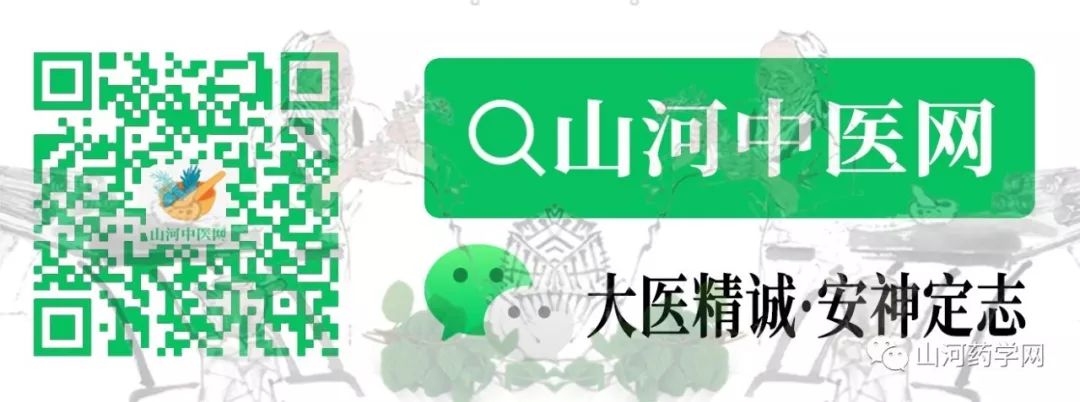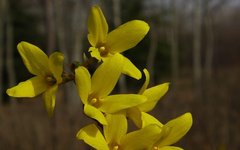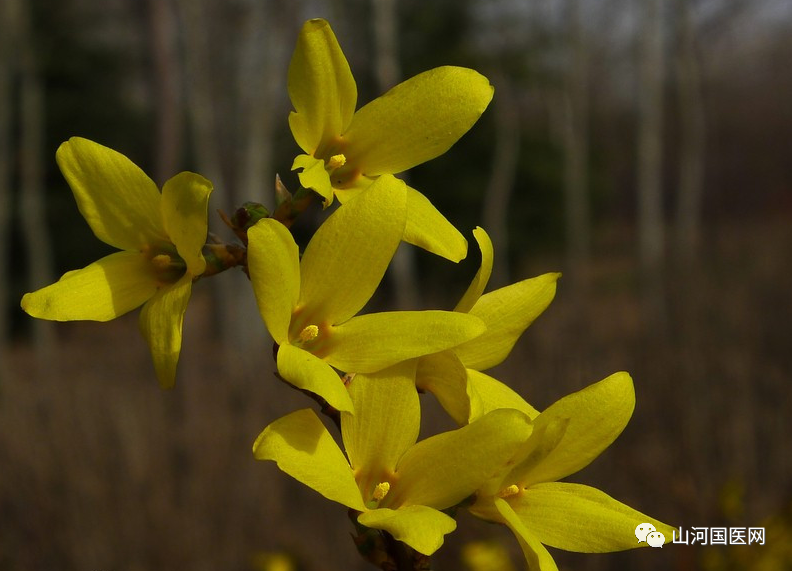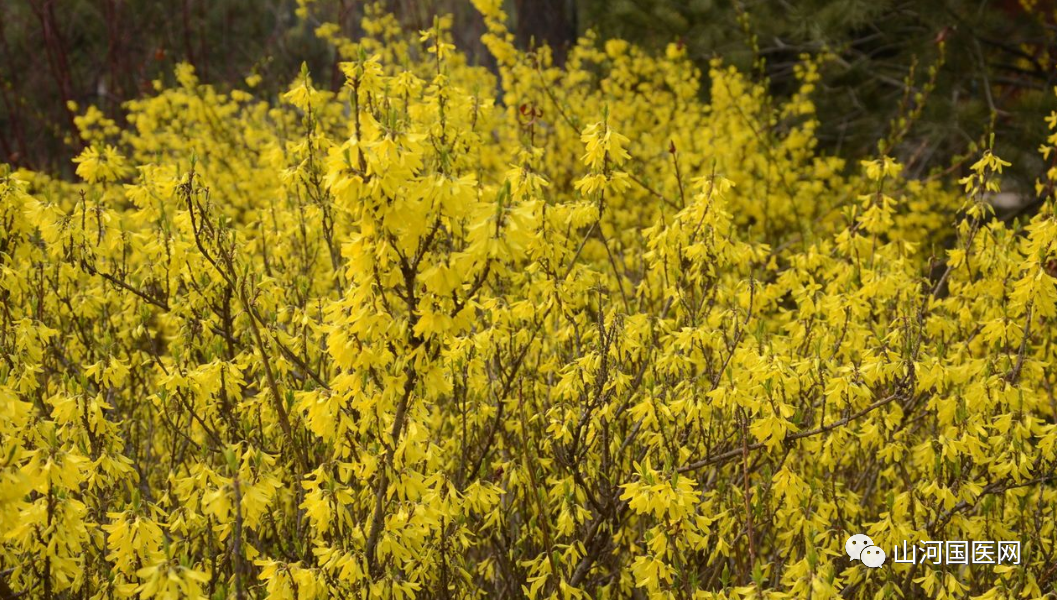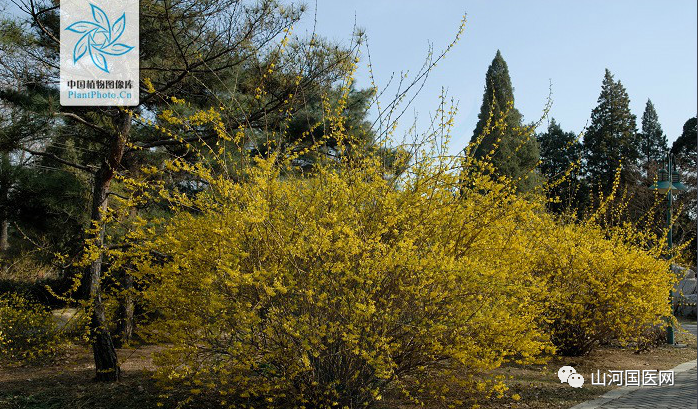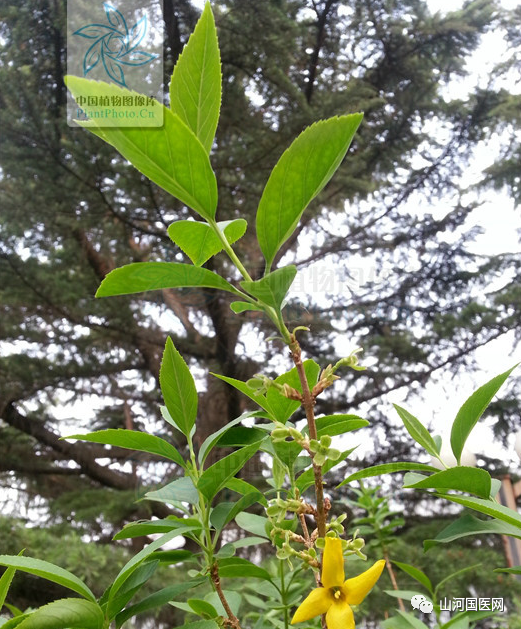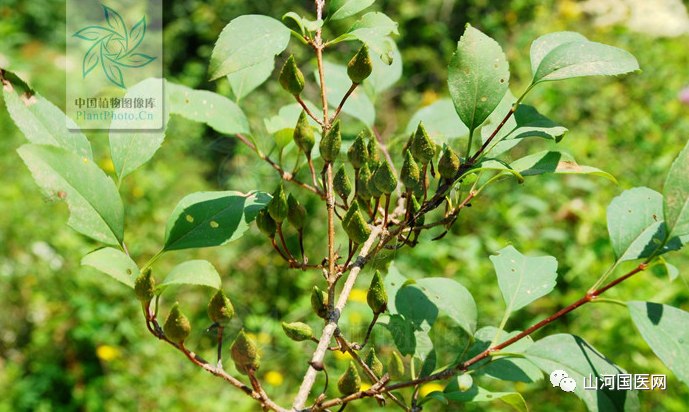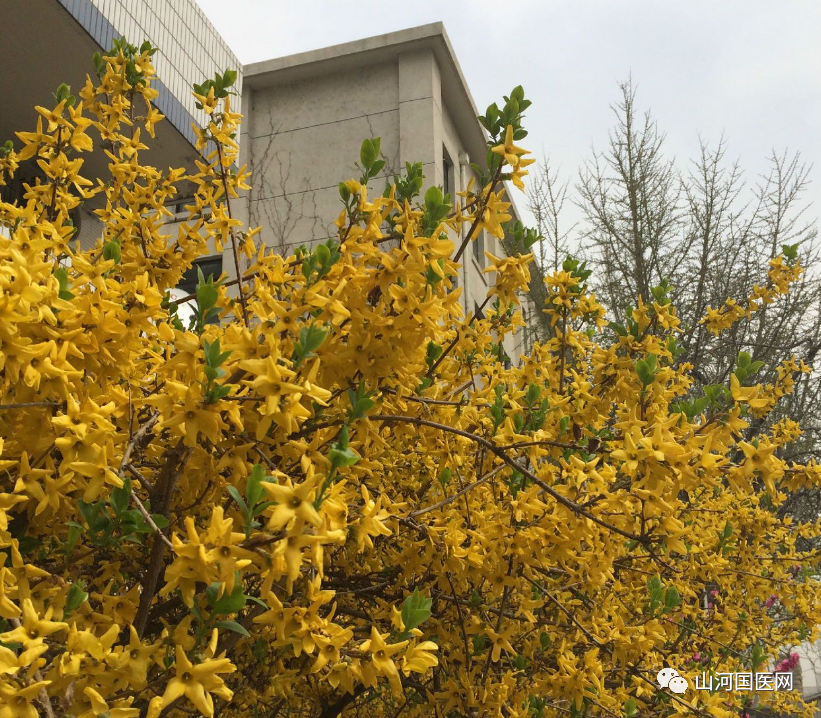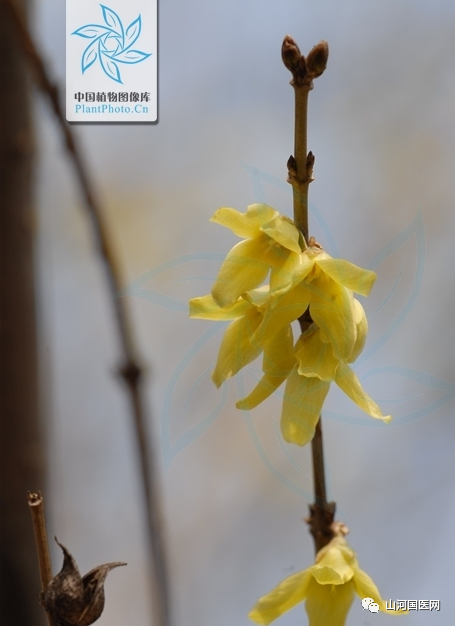| Forsythia Lián Qiáo | |
|---|---|
|
|
|
| Alias | Lián Ké, Huáng Huā Tiáo, Huáng Liàn Tiáo Huā, Huáng Qí Dān, Qīng Qiáo, Luò Qiáo, Hàn Lián Zǐ, Dà Qiáo Zǐ, Kōng Ké, Kōng Qiáo |
| Functions | Clears heat, detoxifies, disperses nodules, reduces swelling. Treats warm heat, erysipelas, rashes, carbuncles, lymphadenitis, and urinary obstruction. |
| First Recorded In | Shén Nóng Běn Cǎo Jīng |
| Toxicity | Non-toxic |
| Meridians Entered | Heart Meridian, Gallbladder Meridian, Lung Meridian |
| Properties | Cool |
| Taste | Bitter |
Forsythia is one of the commonly used traditional Chinese herbs in clinical practice, also known as Huáng Huā Tiáo, Lián Ké, Qīng Qiáo, Luò Qiáo, Huáng Qí Dān, etc. The 2005 edition of the Pharmacopoeia of the People’s Republic of China lists Forsythia as the dried fruit of the plant Forsythia suspensa, belonging to the Oleaceae family. The fruit is harvested when it is still green and immature, referred to as Qīng Qiáo, and when fully ripe and yellow, it is called Lǎo Qiáo.Forsythia exhibits antibacterial, cardiotonic, diuretic, and antiemetic pharmacological effects, and is commonly used to treat acute wind-heat cold, carbuncles, abscesses, lymphadenitis, urinary tract infections, and other conditions. It is a key ingredient in various herbal preparations such as Shuāng Huáng Lián Oral Liquid, Shuāng Huáng Lián Powder Injection, Qīng Rè Jiě Dú Oral Liquid, Lián Cǎo Jiě Rè Oral Liquid, and Yín Qiáo Jiě Dú Granules.Basic Information1. Chinese Name: Forsythia2. Mongolian Name: Xī Rì Yī Sū Lóng Gā3. Aliases: Yī Chuàn Jīn, Hàn Lián Zǐ, Huáng Qí Dān, Lián Ké, Huáng Huā Tiáo, Huáng Liàn Tiáo Huā, Qīng Qiáo, Luò Qiáo, Huáng Shòu Dài, Huáng Shòu Dān, Huáng Jīn Tiáo.4. Medicinal Part: Fruit.5. Collection and Processing: Harvest the fruit in autumn when it is still green, remove impurities, steam, and dry (Qīng Qiáo); harvest when fully ripe, remove impurities, and dry (Lǎo Qiáo); collect seeds (Lián Qiáo Xīn).6. Properties and Taste: The herb is bitter and slightly cold.It clears heat and detoxifies, disperses nodules, and reduces swelling. The Mongolian version is bitter and cool, clearing “Xie Rì” and stopping diarrhea.7. Indications: Used in TCM for initial stages of febrile diseases, wind-heat colds, fever, irritability, sore throat, rashes, erysipelas, lymphadenitis, carbuncles, abscesses, acute nephritis, and heat strangury. The Mongolian version treats jaundice, intestinal pain, “Xie Rì” disease, and intestinal heat.8. Dosage and Administration: 6-9 grams, decocted in water, or made into pills or powders. The Mongolian version is used in pills, powders, or decoctions.9. Precautions: Use with caution in cases of already ruptured abscesses.There are 11 major varieties worldwide, most originating from China, with some from Korea and Japan, and only one from Southern Europe. The name Forsythia commemorates Scottish botanist William Forsyth.In China, the varieties are mostly the dried fruits of Forsythia suspensa. It is distributed in provinces such as Hebei, Shanxi, Shaanxi, Gansu, Ningxia, Shandong, Jiangsu, Henan, Jiangxi, Hubei, Sichuan, and Yunnan. The fruit is harvested in autumn when it is still green, removed of impurities, steamed, and dried, commonly referred to as “Qīng Qiáo”; when fully ripe, it is dried and referred to as “Lǎo Qiáo”. The capital city of South Korea, Seoul, has Forsythia as its city flower.[Processing] Remove impurities, crush, and remove stems.[Properties] Bitter, slightly cold.① Běn Jīng: Bitter, neutral.② Bié Lù: Non-toxic.③ Yī Xué Qǐ Yuán: Zhǔ Zhì Mì Jué states it is cool and bitter.④ Gāng Mù: Slightly bitter and pungent.[Meridians Entered] Enters the Heart, Lung, and Small Intestine meridians.① Tāng Yè Běn Cǎo: Hand and foot Shaoyang, Yangming meridians.② Gāng Mù: Shaoyin Heart, Jueyin Pericardium Qi.③ Léi Gōng Pào Zhì Yào Xìng Jiě: Enters the Heart, Liver, Gallbladder, Stomach, Sanjiao, and Large Intestine meridians.[Functions and Indications – Effects of Forsythia] Clears heat and detoxifies, reduces swelling and disperses nodules, disperses wind-heat, known as the “Holy Medicine for Sores.” Treats warm heat, erysipelas, rashes, carbuncles, lymphadenitis, urinary obstruction, and clears heart fire.① Běn Jīng: Treats cold and heat, mouse paralysis, lymphadenitis, carbuncles, ulcers, goiter, and heat accumulation.② Bié Lù: Eliminates white worms.③ Yào Xìng Lùn: Promotes urination, relieves urinary obstruction, and eliminates heart heat.④ Rì Huā Zǐ Běn Cǎo: Unblocks the small intestine and expels pus.Treats sores, boils, relieves pain, and regulates menstruation.⑤ Lǐ Gāo: Disperses blood stasis and qi stagnation; reduces swelling.⑥ Wáng Hǎo Gǔ: Treats deafness and tinnitus.[Usage and Dosage] Internal use: Decoction, 9-15 grams; or made into pills or powders. External use: Wash with decoction.[Indications and Contraindications] Contraindicated in cases of spleen and stomach deficiency, qi deficiency with fever, and ruptured abscesses with thin pus.① Běn Cǎo Jīng Shū: Do not use if abscesses have ruptured, do not use for heat due to deficiency, and do not use for those with weak spleens and stomachs prone to diarrhea.② Běn Cǎo Tōng Xuán: Long-term use may lead to cold accumulation issues.[Selected Formulas] ① For Taiyin wind warmth, warm heat, warm epidemic, and initial stages with heat but no aversion to cold and thirst: Forsythia 30 grams, honeysuckle 30 grams, bitter root 18 grams, mint 18 grams, bamboo leaves 12 grams, raw licorice 15 grams, mustard seed 12 grams, and fermented soybeans 15 grams. Grind into powder, take 18 grams each time, decoct with fresh reed root until fragrant, then take, do not overboil. For severe cases, take twice a day; for mild cases, take three times a day; if symptoms persist, repeat the dose.(Wēn Bìng Tiáo Biàn Yín Qiáo San) ② For all types of heat in children: Forsythia, Siler, and licorice (roasted) equal parts. Grind into powder, take 6 grams with 1 cup of water, decoct to 70% remaining, strain and take warm.(Lèi Zhèng Huó Rén Shū Forsythia Decoction) ③ For red rashes and toxins: Forsythia alone, decoct and drink.(Yù Qiáo Yī Lìng) ④ For breast abscesses and lumps: Forsythia, male mouse droppings, dandelion, and Chuan Bei Mu, each 6 grams. Decoct and take.(Yù Qiáo Yī Lìng) ⑤ For lymphadenitis that does not resolve: Forsythia, ghost arrow feather, and Qū Mài, and licorice (roasted) equal parts. Grind into fine powder, take 6 grams with rice water before bed.(Yáng Shì Jiā Cáng Fāng Forsythia Powder) ⑥ For tongue ulcers: Forsythia 30 grams, Huangbai 15 grams, licorice 6 grams. Decoct and gargle.(Yù Qiáo Yī Lìng)[Clinical Applications] ① For treating acute nephritis, take 18 grams of Forsythia, add water and simmer until 150 ml, divide into three doses before meals, reduce for children. Depending on the condition, continue for 5-10 days, avoiding spicy foods and salt. In 8 patients, all had edema, blood pressure between 140-200/96-110 mmHg, and urine tests showed protein, granular casts, and red and white blood cells. After treatment, 6 cases of edema completely resolved, 2 showed significant improvement; blood pressure significantly decreased; urine tests showed 6 cases turned negative, 2 improved.② For treating purpura, take 18 grams of Forsythia, add water and simmer to 150 ml, divide into three doses before meals, avoiding spicy foods. Treated 1 case of thrombocytopenic purpura and 2 cases of allergic purpura. After 2-7 days of treatment, all skin purpura resolved. The effect of Forsythia may be related to its high content of rutin, which helps maintain normal capillary resistance, reducing capillary fragility and permeability; additionally, Forsythia seems to have desensitizing effects.③ For treating lung abscesses, prepare Forsythia as an injection, with 1 gram of Forsythia per milliliter. Use tracheal drip combined with intramuscular injection. Tracheal drip generally uses 6-10 ml once a day; after symptoms improve, every other day; as symptoms shrink or close, every week twice. Treated 25 cases, cured 14, improved 10, and 1 died; according to 18 cases, the average treatment lasted 12 days with an average of 26.8 tracheal drips, with a maximum of 50 drips.④ For treating retinal hemorrhage, take 18-21 grams of Forsythia, simmer in water, divide into three doses before meals. In 2 cases of retinal hemorrhage in the macular area, after 20-27 days of medication, significant absorption occurred, and vision improved.[Research] Originates from Shén Nóng Běn Cǎo Jīng.1. Tào Hóngjǐng: Forsythia is found everywhere, now using the stem, flower, and fruit.2. Táng Běn Cǎo: There are two types of Forsythia, large and small. The large type has long narrow leaves, like water mint, with beautiful yellow flowers, growing in wet areas, and its fruit resembles unripe mulberry. The small type grows on hills, with leaves, flowers, and fruit similar to the large type but smaller and finer, used by people in the south. Now in Beijing, only the large type is used, not the stem and flower.3. Běn Cǎo Tú Jīng: Forsythia, now near Beijing and in the Hezhong, Jiangning, Zé, Rùn, Zī Gǔn, Dǐng, Yuè, and Lìzhōu areas, has both large and small types. (Large type) grows in wet areas or on hills. The leaves are green-yellow and narrow, like elm leaves or water mint. The stems are red, about three to four feet tall. The flowers are beautiful yellow, and in autumn, the fruit resembles lotus, producing many seeds, hence the name. The root is yellow like mugwort, harvested in August and dried in the shade. The small type grows on hills, with leaves, flowers, and fruit similar to the large type but finer. The southern variety has narrow and small leaves, short stems, only one or two feet tall. The flowers are also yellow, and the fruit is yellow-black, containing black seeds like millet, also known as Hàn Lián Cǎo, used by southern people for flowers and leaves. Now southern TCM practitioners say there are two types of Forsythia, one resembling unripe mulberry, with a small hard shell and no attached calyx, when cut open, it has a strong fragrance, and the seeds fall off easily, not attached to the stem. The other resembles a lotus, with a soft shell, surrounded by a calyx, with no open veins, and no fragrance, even when dried for a long time, it remains attached to the stem, which is very different. Now the lotus-like type is very common in Jiangnan. The unripe mulberry type comes from Sichuan, and is said to be superior to the southern type, but its stem and leaves are not yet seen.
Various Discussions
1) Shén Nóng Běn Cǎo Jīng: Treats cold and heat, mouse paralysis, lymphadenitis, carbuncles, ulcers, goiter, heat accumulation, and poison.2) Míng Yī Bié Lù: Eliminates white worms.3) Yào Xìng Lùn: Promotes urination, relieves urinary obstruction, and eliminates heart heat.4) Rì Huā Zǐ Běn Cǎo: Unblocks the small intestine and expels pus. Treats sores, boils, relieves pain, and regulates menstruation.5) Zhēn Zhū Náng: Forsythia has three uses: 1) Clears heart meridian heat; 2) Eliminates heat from the upper jiao; 3) Known as the holy medicine for sores.6) Lǐ Gāo: Disperses blood stasis and qi stagnation; reduces swelling.7) Wáng Hǎo Gǔ: Treats deafness and tinnitus.
Forsythia and Jasmine
Forsythia and Jasmine are not the same plant; although both belong to the Oleaceae family, Jasmine is from the genus Jasminum, with the scientific name: Jasminum mudiflorum; while Forsythia belongs to the genus Forsythia, with the scientific name: Forsythia suspensa (Thunb.) Vahl.The main differences between Forsythia and Jasmine are:1) Jasmine is from the Oleaceae family and the genus Jasminum, with a bushy appearance, smaller size, and arching branches that easily droop; Forsythia is from the Oleaceae family and the genus Forsythia, with a bushy or tree-like appearance, larger size, and branches that do not easily droop;2) Jasmine’s young branches are green, while Forsythia’s are darker, generally light brown;3) Jasmine’s branches are solid, with pith; Forsythia’s branches are hollow without pith;4) Jasmine has trifoliate leaves, while Forsythia has simple or opposite trifoliate leaves.5) Jasmine leaves grow symmetrically in a cross shape, are small, oval, entire, and have a pointed tip; Forsythia leaves are ovate, broad ovate, or elliptic-ovate, larger, with regular coarse serrations except at the base;6) Jasmine flowers have six petals, while Forsythia has only four petals;7) Jasmine flowers rarely produce fruit, while Forsythia flowers do produce fruit.Disclaimer:The content on this site is added and organized by users for learning and reference purposes only. The information on the site may not be accurate, comprehensive, or up-to-date, and the content should not be considered the final basis for diagnosing or treating diseases.Shān Hé Zhōng Yī Wǎngreminds users that if you have any physical discomfort, please seek medical attention promptly. Thank you for your support and love; we will strive to do better~!!!
